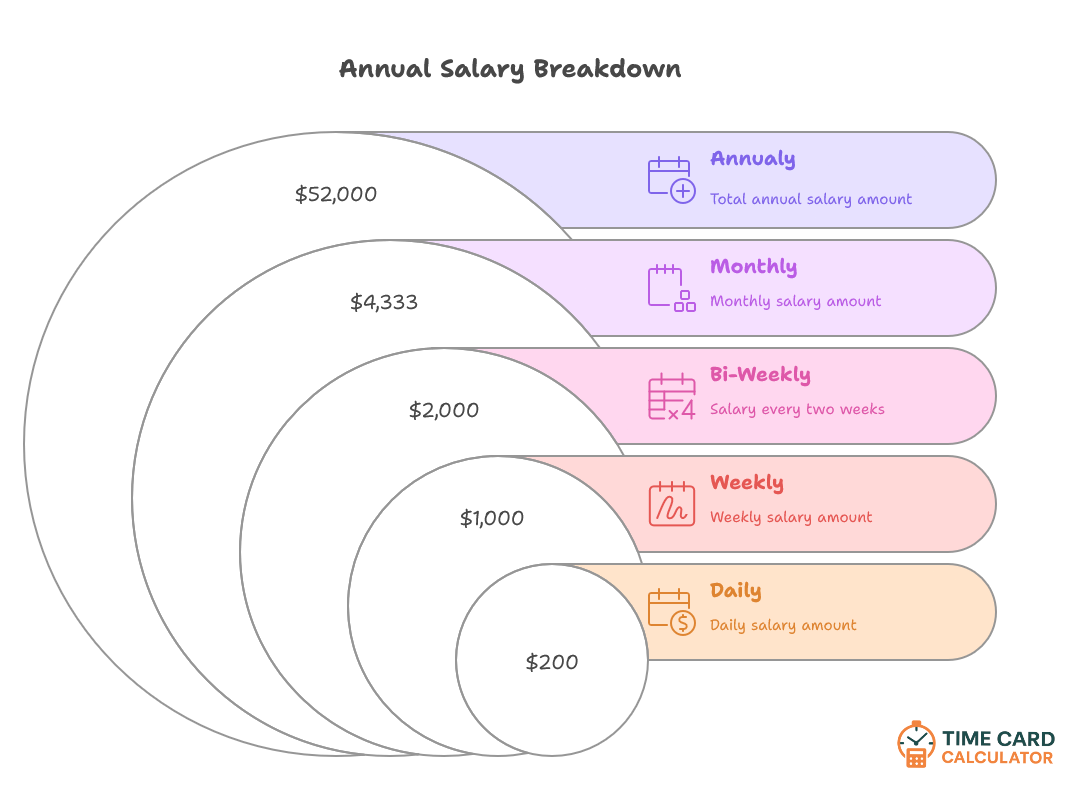Hourly to Salary Calculator
Quickly convert your hourly pay into annual, monthly, or weekly earnings with this simple
Hourly to Salary Calculator. Ideal for job comparisons, budgeting, and understanding your true earnings.
Results
*Calculations are pre-tax and for illustrative purposes only.
How to Use the Hourly to Salary Calculator
Our calculator is designed to be simple and intuitive. Follow these steps to convert your hourly wage to various salary formats:
Step-by-Step Instructions
- Select your currency from the dropdown menu (USD is default)
- Enter your hourly wage in the “Hourly Rate” field
- Input hours worked per week (typically 40 for full-time)
- Specify weeks worked per year (usually 52, or 50 if you take 2 weeks vacation)
- Click “Calculate” to view your comprehensive salary breakdown
What the Results Mean
Once you click calculate, you’ll see your earnings broken down into six different time periods:
- Annual Salary: Your total yearly earnings before taxes
- Monthly Salary: Average monthly income (annual ÷ 12)
- Biweekly Salary: Income every two weeks (annual ÷ 26)
- Weekly Salary: Your weekly earnings (annual ÷ 52)
- Daily Salary: Daily earnings based on 5-day work week
- Hourly Rate: Confirms your original input
Remember: All calculations show gross income before taxes and deductions.
Hourly to Salary Conversion Formula
Understanding the math behind salary conversions helps you make informed financial decisions. Here are the key formulas we use:
Primary Conversion Formulas:
- Annual Salary = Hourly Rate × Hours per Week × Weeks per Year
- Monthly Salary = Annual Salary ÷ 12
- Biweekly Salary = Annual Salary ÷ 26
- Weekly Salary = Annual Salary ÷ 52
- Daily Salary = Weekly Salary ÷ 5 (assuming 5-day work week)
Example Calculation:
If you earn $25/hour, work 40 hours/week, 52 weeks/year:
Annual Salary = $25 × 40 × 52 = $52,000

These calculations assume consistent work schedules. For irregular hours, consider using our Time Card Calculator to track actual hours worked.
Why Use This Calculator?
Converting hourly wages to salary equivalents serves multiple important purposes in your financial planning:
- Job Comparison: Easily compare hourly positions with salaried roles to make informed career decisions
- Budget Planning: Understand your monthly and weekly income for better budgeting
- Negotiation Tool: Know your worth when discussing compensation with employers
- Financial Goal Setting: Calculate how many hours you need to work to reach income targets
- Tax Planning: Estimate your tax bracket and plan accordingly with help from tools like the IRS Tax Withholding Estimator
- Career Planning: Visualize your earning potential across different time periods
Examples of Hourly to Salary Conversion
Here are common hourly rates converted to annual salaries, assuming 40 hours per week for 52 weeks:
|
Hourly rate
|
Annual Salary
|
Monthly
|
Biweekly |
Weekly |
|---|---|---|---|---|
|
$12 |
$24,960 |
$2,080 |
$960 |
$480 |
|
$15 |
$31,200 |
$2,600 |
$1,200 |
$600 |
|
$20 |
$41,600 |
$3,467 |
$1,600 |
$800 |
|
$25 |
$52,000 |
$4,333 |
$2,000 |
$1,000 |
|
$30 |
$62,400 |
$5,200 |
$2,400 |
$1,200 |
|
$40 |
$83,200 |
$6,933 |
$3,200 |
$1,600 |
|
$50 |
$104,000 |
$8,667 |
$4,000 |
$2,000 |
For reverse calculations (salary to hourly), use our Salary to Hourly Calculator.
Hourly vs Salary Pay: What’s the Difference?
Understanding the differences between hourly and salary compensation helps you make better career decisions. According to US News, both payment structures have distinct advantages depending on your lifestyle and career goals.
Hourly Pay Advantages
- Overtime Pay: Earn 1.5x your rate for hours over 40/week
- Flexible Scheduling: Often more control over your hours
- Clear Boundaries: No expectation to work unpaid hours
- Direct Pay Correlation: More hours = more money
- Overtime Protection: Federal law protects your right to overtime pay
Best For:
People who value work-life balance, want overtime opportunities, or prefer flexible schedules. Use our Time and a Half Calculator to calculate your overtime earnings.
Salary Pay Advantages
- Predictable Income: Same amount every pay period
- Better Benefits: Often includes health insurance, 401k, PTO
- Career Advancement: More opportunities for promotion
- Professional Status: Often viewed as more prestigious
- Job Security: Generally more stable employment
Best For:
Professionals seeking career growth, consistent income, and comprehensive benefit packages.
Understanding Your Take-Home Pay
Your calculated salary represents gross income before deductions. Your actual take-home pay will be lower after:
- Federal Income Tax: Varies by income bracket (10%-37%)
- State Income Tax: Varies by state (0%-13.3%)
- FICA Taxes: 7.65% (Social Security + Medicare)
- Benefit Deductions: Health insurance, 401k contributions, etc.
For accurate take-home pay calculations, consider using the SmartAsset Paycheck Calculator which factors in your specific tax situation and location.
Other helpful calculators
FAQ – Hourly to Salary Questions Answered
Make Informed Financial Decisions
Understanding your earning potential is the first step toward financial success. Use our Hourly to Salary Calculator to:
- Compare job offers accurately
- Plan your budget with confidence
- Set realistic financial goals
- Negotiate better compensation
Start calculating your salary potential today and take control of your financial future!
